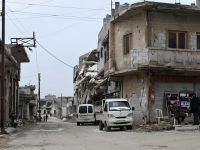Mayon volcano in the Philippines erupted again Tuesday, as disaster officials struggled to prevent some of the 41,000 evacuees from returning to their homes.
The Philippine Institute of Volcanology and Seismology (Phivolcs) said Mayon had a "minor explosion with a small pyroclastic (volcanic debris) flow" at 2:28 pm (0628 GMT), its first sign of activity after a lull of almost two days.
Phivolcs warned that there would be calm periods while the volcano remained in a state of eruption.
"We have also experienced these periods of quiet, if we compare (with other volcanos) there were also incidents of calm and then there was a big bang," disaster official Allan Virtucio warned.
The 2,467-meter (8,141-foot) high Mayon, famous for its near-perfect cone, erupted on Sunday lighting up the night sky with crimson flames and sending rivers of molten lava down its slopes.
The provincial government listed 41,456 people packed into 23 schoolhouses converted into cramped evacuation centers, vulnerable to disease outbreaks due to lack of proper sanitation facilities.
At one overcrowded evacuation centre, a year-old boy died of pneumonia on Tuesday.
Tuesday's minor blast was preceded by three small explosions on Monday afternoon which sent plumes of ash and steam into the air.
"Phivolcs expects more explosive eruptions in the following days," the agency said in a statement.
The highest of a five-step alert level remained in effect with residents barred from entering the six-to-eight kilometer (3.7-five mile) "permanent danger zone" around Mayon.
But many farmers ignored warnings and were leaving evacuation centers during the day to check their property and guard their livestock and crops from possible looters.
Heavy rain Tuesday also raised fears that the tonnes of volcanic debris dumped on Mayon's slopes would turn into a destructive mudflow that could sweep through gullies and ravines, swallowing homes and farms, Cedric Daep, the provincial disaster management chief warned.
The overcast conditions prevented residents from seeing the cone of the high volcano which provides the most visible clue of when more explosions are imminent.
Experts have warned that Mayon, a popular tourist attraction located about 325 kilometers (200 miles) south of Manila, usually remains active for a week or two after it erupts.
Up to 80,000 people were displaced in February 2000 during its last eruption. The most destructive eruption was in 1814, when 1,200 people were killed and an entire town was buried in volcanic mud.
At the evacuation centers, many people had to sleep on cold concrete floors and were given only one ration of food a day.
Others, who could not be accommodated in the classrooms, had to construct makeshift tents and shelters on the school grounds to protect them from the rain.
The provincial government dispatched fire trucks to alleviate the shortage of drinkable water for the evacuees. Agriculture officials were ordered to check if ash falling from the volcano would affect crops -- LEGASPI, Philippines (AFP)
© 2001 Al Bawaba (www.albawaba.com)







